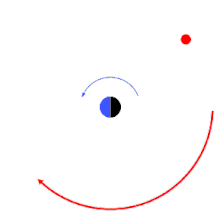
Retrograde motion in astronomy is, in general, orbital or rotational motion of an object in the direction opposite the rotation of its primary, that is, the central object (right figure). It may also describe other motions such as precession or nutation of an object's rotational axis. Prograde or direct motion is more normal motion in the same direction as the primary rotates. However, "retrograde" and "prograde" can also refer to an object other than the primary if so described. The direction of rotation is determined by an inertial frame of reference, such as distant fixed stars.
In the Solar System, the orbits around the Sun of all planets and most other objects, except many comets, are prograde. They orbit around the Sun in the same direction as the sun rotates about its axis, which is counterclockwise when observed from above the Sun's north pole. Except for Venus and Uranus, planetary rotations around their axis are also prograde. Most natural satellites have prograde orbits around their planets. Prograde satellites of Uranus orbit in the direction Uranus rotates, which is retrograde to the Sun. Nearly all regular satellites are tidally locked and thus have prograde rotation. Retrograde satellites are generally small and distant from their planets, except Neptune's satellite Triton, which is large and close. All retrograde satellites are thought to have formed separately before being captured by their planets.
Most low-inclination artificial satellites of Earth have been placed in a prograde orbit, because in this situation less propellant is required to reach the orbit.